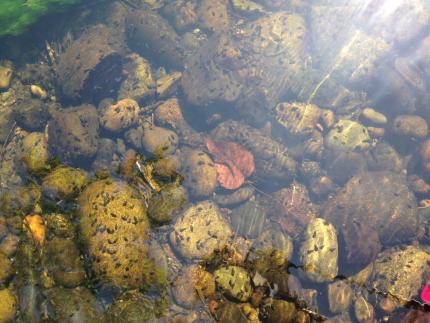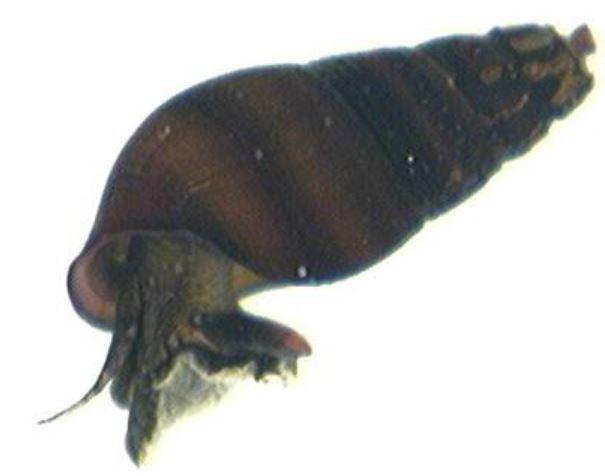Low-
Moderate
The three-band juga is a freshwater aquatic gastropod. Their population size is considered low and the trend is unknown. Juga species generally require cold, clear, well-oxygenated water; they are sensitive to pollution, and intolerant of warm waters, low dissolved oxygen, or major seasonal fluctuations. Destruction of springs by grazing, logging, and water diversion, for such things as for water supply and fish hatcheries, has already caused extensive extinction of Juga species throughout western North America.
Description and Range
Physical description
Juga species are medium-sized, aquatic, gilled snails with tall conical shells. This genus (Juga) is part of the family Semisulcospiridae. The taxonomy of the family Semisulcospiridae, like most freshwater gastropods, has been based largely on shell morphology, and the tremendous variation makes the current taxonomy problematic and species identification difficult. Current work using reproductive anatomy and DNA to help resolve some of the taxonomic problems will likely result in changes in taxonomy in the future.
Ecology and life history
Juga species are native to the streams and springs of the Pacific Northwest, California, and the Great Basin. The three-band juga occurs in shallow, slow flowing springs and permanent seeps, sometimes associated with talus. Most often, these are covered by dense brush; the substrate ranges from bare rock faces to mud and sand. Rarely, this species occurs in smaller spring-fed streams. They exhibit seasonal migrations both upstream and downstream.

Juga snails are characterized as rasper-grazers, feeding on both algae and detritus on rock surfaces and deciduous leaf litter.
The egg masses of Juga snails are most often found in loose (non-cemented) but stable cobble substrate, with free and fairly vigorous flow through at least the upper substrate layers. Most Juga species appear to breed and lay eggs once a year as adults. Egg masses are located under rocks in the spring, and eggs hatch in one month. Juga species live from five to seven years, reaching sexual maturity in three years, and can continue to grow.
Geographic range
Where found, Juga species can comprise over 90 percent of the invertebrate biomass in some streams.
Three-band juga are known from scattered sites, mostly in the eastern Columbia Gorge: Skamania and Klickitat counties, Washington, and Hood River, Wasco, Sherman, and Gilliam Counties, Oregon. This species seems to be restricted in distribution in Washington to the Columbia River Gorge, which historically provided abundant springs for habitat.
Climate vulnerability
Sensitivity to climate change
Low
There is limited information on the sensitivity of this species to climate change. This species is found in shallow, slow-flowing springs and seeps and is sometimes associated with talus. Activities or events that alter conditions, such as moisture levels and temperature, may make this species vulnerable.
Exposure to climate change
Moderate
- Increased water temperatures
- Reduced soil moisture and/or drought
- Altered fire regimes
Conservation
Conservation Threats and Actions Needed
- Fish and wildlife habitat loss or degradation
- Threat: Water diversion; habitat loss to development.
- Action Needed: Management recommendations; identification and protection of sites.
- Resource information collection needs
- Threat: Needs formal species description and status assessment.
- Action Needed: Formal species description, and status assessment.
- Agriculture and aquaculture side effects
- Threat: Intensive livestock use may trample the species or reduce riparian vegetation.
- Action Needed: Install fencing to carefully manage or prohibit livestock access to occupied riparian areas.
This species' climate vulnerability is assessed as "moderate to high." Climate vulnerability (PDF) is a way to assess the degree to which a habitat or species is susceptible to, and unable to cope with adverse impacts of climate change.
Resources
References
Frest, T. J. and E. J. Johannes. 1995. Interior Columbia Basin mollusk species of special concern. Final report to the Interior Columbia Basin Ecosystem Management Project, Walla Walla, WA. Contract #43-0E00-4-9112. 274 pp. plus appendices.
Lee, T., J. J. Kim, H. C. Hong, J. B. Burch and D. O´Foighil. 2006. Crossing the Continental Divide: the Columbia drainage species Juga hemphilli (Henderson, 1935) is a cryptic member of the eastern North American genus Elimia (Cerithioidea: Pleuroceridae). Journal of Molluscan Studies 72:314-317.
O’Foighil, D. O., T. Lee, D. C. Campbell, and S. A. Clark. 2009. All voucher specimens are not created equal: A cautionary tale involving North American pleurocerid gastropods. Journal of Molluscan Studies 75:305-306.
USFWS. 2011. Endangered and Threatened Wildlife and Plants: 90-day finding on a petition to list 29 mollusk species as threatened or endangered with critical habitat: proposed rule. Federal Register 76 (No. 193, October 5, 2011): 61826-61853
